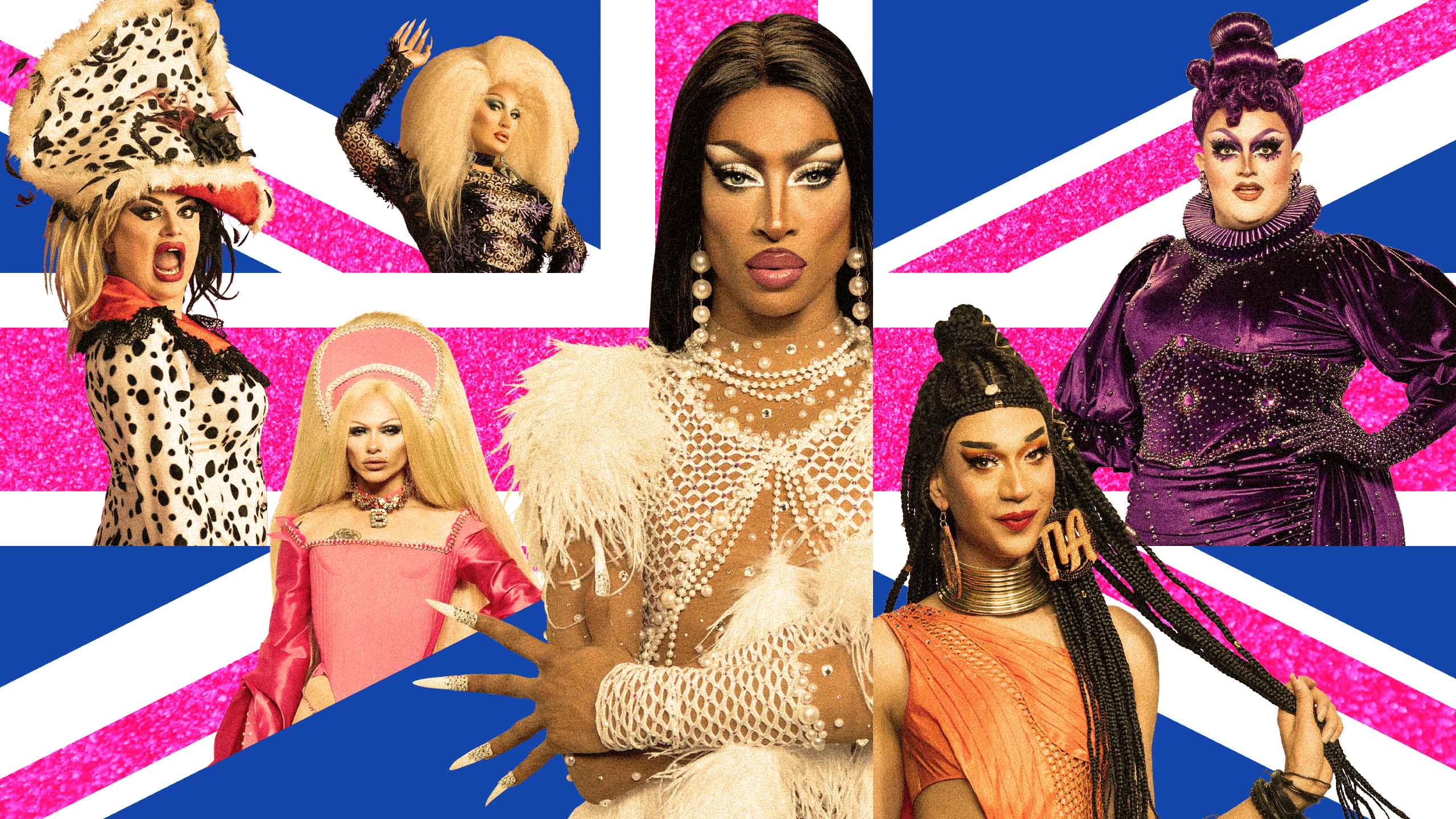When RuPaul’s Drag Race first announced two separate seasons starting in January of 2021—Season 13 in the U.S., and UK Season 2 overseas—it felt like the latest escalation in a years-long campaign. Last year, fans were already complaining about “too much Drag Race!,” with Season 12, All Stars 5, Canada’s Drag Race, Secret Celebrity Drag Race, RuPaul’s Drag Race Vegas Revue and Drag Race Holland all airing, though at least not simultaneously for the most part. (Looking back, the month when both All Stars 5 and Canada’s Drag Race aired episodes was a warning.)
But now? Two seasons of RuPaul-hosted, Michelle Visage-judged Drag Race airing at the same time for 10 weeks. Some may have been tempted to just skip UK and binge it later. Season 13 is enough, but two seasons at once? Too much Drag Race—once more, with feeling!
As it turned out, though, skipping UK Season 2 would have been folly. While Season 13 has largely underwhelmed (though for what it’s worth, I do think it’s on an upswing), UK Season 2 was a marvel. Boasting one of the most energetic, charismatic casts we’ve ever seen on Drag Race, this season built on what worked so well about UK Season 1.
It gave us a terrific, varied final four of Bimini Bon Boulash, Ellie Diamond, Lawrence Chaney and Tayce. It gave us the drama of Chipgate, in which two queens wore fish and chips-inspired outfits for the same runway. It gave us RuPaul yelling that he doesn’t want to see “any fucking H&M.” It gave us Bimini’s Katie Price Snatch Game, and the joyous, perfect Eurovision-style bop “UK Hun.”
Quibbles about the uneven ending aside, UK Season 2 was nothing short of brilliant. It also made quite clear that, in a battle between the two simultaneous seasons, the British series was the definitive winner.
Back in late 2019, I wrote a piece after the RuPaul’s Drag Race UK Season 1 finale that argued that Drag Race U.S. could learn a lot from its sister across the pond. While not every one of those suggested changes has made their way onto the mothership show (I’m still waiting and hoping for Untucked to get merged into the main show like it is on UK), some have: Drag Race started featuring just one guest judge off and on during Season 12, and has made that permanent for Season 13 due to COVID-19 restrictions. And while it’s still not quite as raunchy as UK, the main show has gotten some of its naughty sense of humour back.
“The original recipe of RuPaul’s Drag Race has, over the years, morphed into something far more driven by finances, and I’m not just talking about the cash tips of $5,000.”
But I think there are even more lessons the U.S. show can take from UK—chief among them being the latter’s scrappy vibe. The original recipe of RuPaul’s Drag Race has, over the years, morphed into something far more driven by finances, and I’m not just talking about the cash tips of $5,000 for winning challenges. As the franchise has grown and gained a broader fanbase, the cost of entry for contestants—for their clothing, wigs and accessories—has ratcheted up, too.
Coming with anything less than a high-budget wardrobe is just asking for criticism on the runway. Sure, Ru and Michelle will say it’s not about money, but there’s a reason why Monique Heart, who spoke openly about not having the same access to designer and custom clothes in Season 10, performed much better on All Stars when she had the finances to upgrade her wardrobe.
This Drag Race arms race has been accelerating over the years, but shifted into hyperdrive when the series moved to VH1. On that season, several of the queens discussed having to use their life savings—or even go into debt—just to afford all the outfits they needed to compete. The pandemic has not changed that spending, either; as Season 10 favourite Asia O’Hara pointed out on Twitter recently, the Season 12 and 13 dolls have had to spend just as much on outfits as ever, but no longer get the benefit of extensively touring immediately following their season to recoup the money they invested.
While it’s tempting to chalk this up to a show-created problem, the main series’ fandom seems to expect this level of quality on the runway, too. Queens who deliver less than their best are dismissed as not true threats for the crown—Kandy Muse, in particular, has gotten flack for her runways repeatedly this season. In the most recent episode, for instance, despite a solid commercial in the branding challenge, the overwhelming fan response was that Kandy deserved to be in the bottom for her alien runway (one she had to defend on Twitter).
Conversely, during Drag Race UK Season 2, when Ru exploded at Joe Black for wearing an H&M dress in the RuRuVision challenge, the fanbase leapt to his defense. Tia Kofi was absolutely beloved by the fanbase this season for her hilarious confessionals and vulnerability with the other queens, despite routinely turning out poor looks on the runway. And one of the most consistently praised queens on the runway, by fans and judges alike, was Ellie Diamond, who makes all of her own drag.
So what’s the difference? If the same fanbase is largely watching both shows—though not entirely, of course—then why are the expectations of UK queens so different? My take: The responsibility lies with the show for creating those expectations. Baga Chipz, a finalist in UK Season 1 and largely its breakout star, made it to the finale almost exclusively on her charm and talent. Her runways were routinely among the worst of the lot, but she was so strong in the challenges that it didn’t matter. And the judges didn’t make her runways a big deal! So when we saw queens like Tia Kofi do roughly the same in season 2, the understanding was that, despite a lack of runway prowess, they were still queens to root for.
Modern Drag Race U.S. is consistently setting the opposite standard: That to have a real shot to win, a doll needs to turn it out in the fashion department. True, queens have made it to the end in recent seasons based on less-than-perfect outfits. Yvie Oddly even won the whole competition over the more polished Brooke Lynn Hytes. But winners like Sasha Velour, Aquaria and Jaida Essence Hall—as well as the many queens of All Stars raising the fashion bar—have looked flawless throughout their runs. This season’s frontrunners, Symone and Gottmik, are no exception, having worked closely with designers on custom outfits for the competition.
“There has to be a leveling of the playing field—an understanding, projected by the show, that a queen may not be able to bring tens of thousands of dollars worth of garments.”
The solution to this on Drag Race U.S. isn’t to make runway looks meaningless. Some queens are look queens, and have access to high-fashion garments that stun the judges. To suddenly de-emphasize runway entirely would be unfair to them, and it’s not even what UK does. But there has to be a leveling of the playing field—an understanding, projected by the show, that a queen may not be able to bring tens of thousands of dollars worth of garments, and that their other skills will be given appropriate weight in both the judging and fan appreciation.
Another potential way forward: Change up the runway categories to be more reminiscent of classic seasons. Gone are the days of “Death Becomes Her” and “Spanish Telenovela Realness” runway categories; now, we have fabric and colour themes. UK, by contrast, has kept up that classic spirit, with prompts like “A Day at the Seaside” and “Monster Mashup.” The judging is thus more about the interpretation of the prompt, rather than just which look is most high-quality (i.e. most expensive).
This is just one particular way in which Drag Race UK differs from the U.S. series. A wide gap in both quality and audience reception can’t just be chalked up to this one thing, but it feels like something genuinely fixable on the American series’ part—if they’re willing to change judging standards and categories moving forward.
Other potential lesson the U.S. version can learn from UK: Keep the drama as organic as possible, stemming from the queens themselves instead of forcing it. Bring on MNEK as the producer and coach for musical challenges. He’s shown twice now that he’s very capable of coaching queens to greatness. And please, please consider folding Untucked into the main show. The episodes can still be two hours total if need be! But the flow of the episodes are so much better with Untucked inside them than as an aftershow.
Overall, though, the primary focus should be on making Drag Race U.S. feel like a labour of love in the way UK does. Making it all a bit less polished, focusing on a wider variety of talents in judging and speeding up the pace of the competition are all ways to bring a fun, energetic spirit back to Drag Race.
Though having both seasons air simultaneously felt exhausting when first announced, I ultimately think it’s been more instructive than anything. Watching each series back-to-back, week by week, has given us a direct comparison between the two series. And when all was said and done, it was UK that won, hun.
Do you agree with Kevin? Is Drag Race UK the superior Drag Race show? Join us Fridays at 4 p.m. EST for the livestream Kiki with Kevin to share your thoughts on this and on all things Drag Race-related.


 Why you can trust Xtra
Why you can trust Xtra


